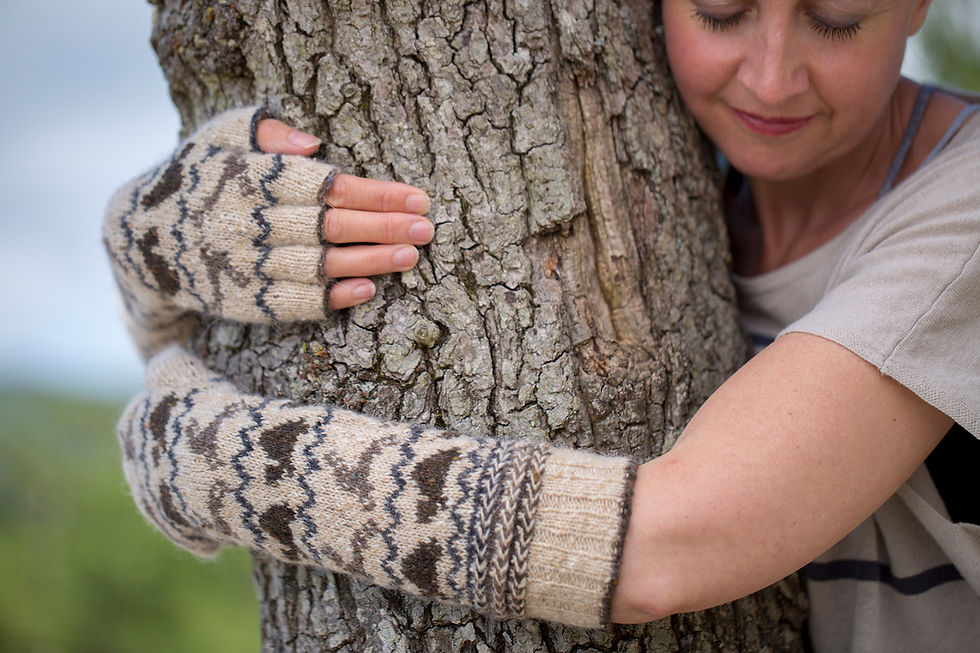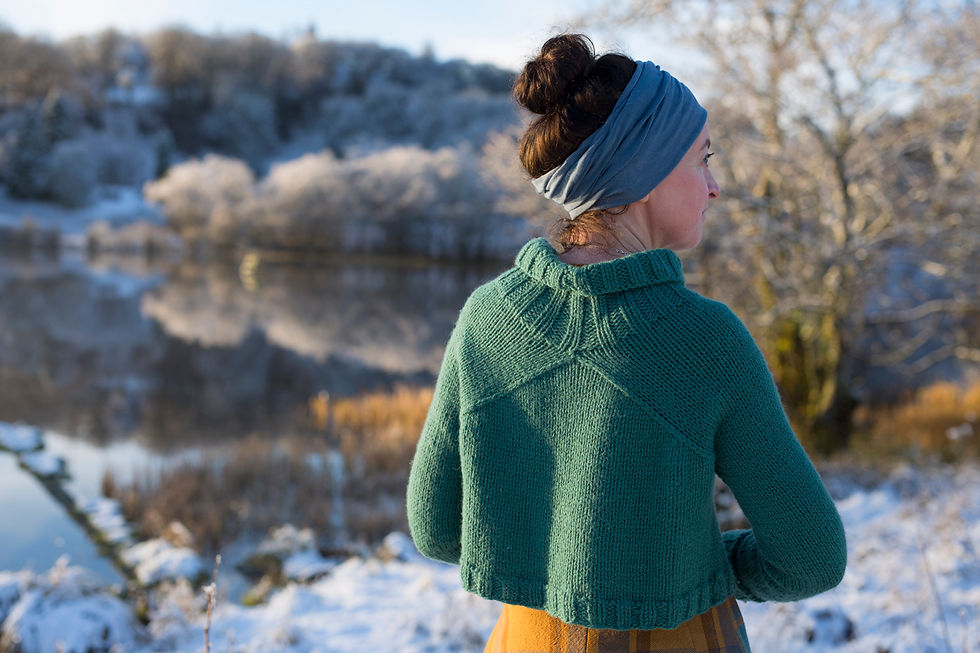KATE DAVIES NEAR HER HOME IN WEST CENTRAL SCOTLAND

Kate Davies is a remarkable woman. She has a doctorate in 18th-century history and was a professor until she had a major stroke on February 1 2010 at age 36 that took away function on the entire left side of her body, ended her academic career, and had her wheelchair-bound living in a brain injury unit in an Edinburgh hospital for six months. Before the stroke, she was also an accomplished knitter and pattern designer.
Her post-stroke body worked just fine on its right side but her left side was now pretty much non-functional, along for the ride because her damaged brain didn’t know what to do with it. The stroke was caused by a congenital hole in her heart she had no idea was there that allowed two blood clots to travel to her brain.
Amazingly, in the eight years since the stroke, she’s combined her interests in historical writing and practical creativity with her skills in research, design, and writing to teach herself to knit again – and along the way founded a company called Kate Davies Designs (KDD) that creates digital patterns for hand knitters. Through KDD she’s produced eight books: Colours of Shetland (2012), Yokes (2014), Buachaille: At Home in The Highlands (2015), The Book of Haps (2016), Shetland Oo (2016), Inspired by Islay (2017), Happit (2017) and West Highland Way (2018).
In 2016, her company was named UK Microbusiness of the Year by the Federation of Small Business & Worldpay.
She has worked with museums and heritage organizations, sharing her expertise (including the Tate Modern, Shetland Amenity Trust, and Gawthorpe Textiles) and has also contributed to BBC radio programs on diverse topics such as the landscape of British knitting and the history of socks. She was the first ambassador of Shetland Wool Week and her knitting designs have been featured on BBC television.
Now she has another book due out this month (July 2018): Handywoman. This one is an exploration of her experiences of serious brain injury, craft, and creativity. (Barnes, 2016) & (Davies, 7/1/2018)
You knitters and crocheters may recognize her name and know her exquisite patterns from the Ravelry site.

THE STROKE
In Kate’s own words, this is what happened on 1 February 2010:
“I was walking from the train station to work and it just felt like a gun had gone off and I fell over. I had a stroke, which was caused by a congenital heart condition which I knew nothing about…. I was paralysed on my left side and couldn’t hear properly and I was advised not to return to my old job.” (Barnes, 2016)
WHAT SHE DID TO REGAIN HER LIFE
“My grandmother taught me how to knit. But, after the stroke, I couldn’t do things like plait my hair. I couldn’t even roll socks into a ball…. My hand had no memory of doing that action. I couldn’t use a fork. But teaching myself to do those things was incredibly important and it meant I could knit again…. It was horrendous but those small acts were so important.
“The first thing I knitted was a pair of socks and I think that beats anything I had ever knitted before.
“When you’re in a brain injuries unit, they are very realistic. I couldn’t hear properly, which would have made going back to my lecturing job very difficult…. I was also in a wheelchair so it wasn’t an option immediately. I wasn’t in a hurry to get back to work but, when the occupational therapist asked what I was going to do in the short and long term, I said I was going to make knitting patterns and sell them. They thought I was mad.
“There are things I love doing that I can’t do. I can’t run or swim…. But I do have a good life and I’m happy.” (Barnes, 2016)
A post script to that 2016 interview with Julie-Anne Barnes for the Daily Record: Recently Kate has learned to swim again in open water, which brings her much pleasure.
Kate Swimming in Carbeth Loch near her home in Scotland
Filmed by Tom Barr, her photographer husband
About how swimming has helped, in her own words:
“On a general everyday level, in my post-stroke body I feel uncomfortable pretty much all of the time. I’m continually aware of being lopsided, of my left side moving hesitantly or behaving unpredictably, of the feeling that my brain is continually ‘working’ to keep my left arm and leg operating in tandem with my right. Simply being in my body feels effortful, and I am always aware of the unbalance between my left and right sides even when I’m just sitting still. In a very basic way, I often feel it is impossible to simply relax in my own skin. But in the water, my body is supported. In the water, the movement of my stroke-affected limbs feels much more natural and, though I am still aware of the weakness of my left side in comparison to my right, I have a much greater sensation of balance than I do when I’m walking, for example. Swimming means my limbs can move at what seems like speed to me, and with something that feels like ease – a simple sensation which I very rarely feel (and whose absence has been one of the hardest things for my body to deal with in the 8 years since my stroke). Swimming has helped my bilateral movement, my balance, and it has clearly helped with my body’s strength as well. In the water I just feel physically capable. On land I rarely have that feeling.
“So, if you’ve had a stroke, I would heartily recommend experimenting with swimming as an exercise (as and when you have enough energy to try it). Swimming has not improved the unpredictable spasticity of my stroke-affected limbs, nor their inability to operate in ‘extreme’ situations of stress or cold, but it has helped enormously with their strength, balance, and co-ordination.” (Davies, 7/1/2018))
TEDx TALK ABOUT HER STROKE
In April 2018 Kate gave a TEDx Talk at Heriot-Watt University in Edinburgh about her 2010 stroke and how she used knitting to help work her way back into a creative, productive life. I’ve found this talk quite useful as I work through the limitations I encountered one moment to the next after breaking my left wrist seven months ago. I think you’ll find that watching it will be worth 15:43 minutes of your time.
HANDYWOMAN

Kate’s latest book, Handywoman, explores her experiences of brain injury, craft, and creativity. It’s release date is this month (July 2018).
“Handywoman is about what it means to knit a sweater. About the idea of walking when one finds oneself in a body that no longer walks. About learning how to dance when half of your body barely moves at all. About just how difficult it is to accept the self after major physical change. About the resourcefulness and joy of an ordinary working-class childhood. About love and friendship. About a dog. About finding oneself, as a maker, among an incredible group of makers. About hands. About the brain. About hair and identity. About extraordinary tools and objects. About life not turning out quite as you expected. About working towards a better life precisely because of its unexpected nature. About understanding limitation as a creative resource rather than as an impediment. Handywoman is about hearing a poem that chimes so strongly with your own experiences that it seems to speak to you directly. It’s about finding a sense of place and purpose among some remarkable women and their remarkable islands. It’s about living life creatively, and being supported by an extraordinary creative community. And its about thinking about how good design might contribute to the development of a more inclusive, a more human, public sphere.”
– from the Introduction to Handywoman
About the book, in her own words from her blog:
“I initially decided to write Handywoman after being interviewed on BBC Woman’s Hour, which led to a discussion with a literary agent. This agent was really smart, interesting, incredibly professional and represented other writers of what the book trade describes as “intelligent non-fiction” whose work I really admired. I’d had no thought of writing something classed as ‘memoir’ but she thought that I had something to say, and through conversing with her I agreed that I probably did. Without this literary agent’s encouragement, I’m not sure I’d ever have pursued the project that became Handywoman: researching and writing a substantial (85,000 word) book is no small undertaking, especially when the work involved me grappling with, and articulating my thoughts about, some potentially thorny and tricky topics involved in my experience of brain injury and disability.
“The fact that a neurologist (initially) didn’t believe I’d had a stroke because of my gender and mental-health history, and that it took 36 hours before my brain injury was correctly investigated, diagnosed and received any sort of treatment, is not something that particularly bothers me from day to day, but it is a messy part of my narrative, and to tell the truth of it I had to think carefully about debates surrounding somatic disorders, gendered bias, and patient care, as well as the story of my own stroke.
“There were also some parts of my narrative to which I knew it would be difficult for me to return – such as the overwhelming grief I felt upon coming home from hospital and having to live life as a newly disabled woman among the lost remnants of my able-bodied self. But when I sat down to process these experiences for the purpose of the book, I found that thinking and writing about them was not only useful for me, but inspired me to think and write about lots of other things as well.
“In short, I soon found that in writing this book I was not simply writing about myself: I was writing about what really interested me, as both a thinker and a maker. And as the project developed, I began to wonder whether I would be true to it and to the Handywoman philosophy I was espousing, if I didn’t just make it myself. I now run a small publishing business after all, and one of the things I enjoy most about my job is making really nice books.” (Davies, 6/16/2018)

Kate Davies is obviously an extraordinary human being who has put her many skills and her determination together to solve the puzzle of how to put herself back together after a devastating blow to her health.
You can read more about Kate in her own words by subscribing to her blog.

Here’s a link to her Kate Davies Designs site.

Many thanks to Susan Bloom Lipson, another expert and prolific knitter, for bringing Kate Davies and her extraordinary determination and talents to my attention.
“Everybody has resources. Sometimes they are used in your job and sometimes they are an opportunity to forge another path.”
– Kate Davies
REFERENCES
Barnes, J-A. (2016). Stroke survivor, 43, on how knitting gave her a new lease of life: KATE DAVIES nearly died but her collapse has given her a renewed sense of life and now her designs are going global. Daily Record. See: https://www.dailyrecord.co.uk/news/real-life/stroke-survivor-43-how-knitting-8532660
Davies, K. (4/10/2018). Handywoman: Making a Creative Life | Kate Davies | TEDxHeriotWattUniversity. See: https://www.handywomanbook.com/handywoman-tedx-talk
Davies, K. (6/15/2018). Making Handywoman. See: https://katedaviesdesigns.com/2018/06/16/making-handywoman/
Davies, K. (7/1/2018). Swimming in Carbeth Loch. See: https://katedaviesdesigns.com/2018/07/01/swimming-in-carbeth-loch/
Davies, K. (2018). Handywoman.
Davies, K. (2018). Kate Davies Designs. See:
Ravelry. See: https://www.ravelry.com
© Copyright 2018. Joan Rothchild Hardin. All Rights Reserved.
DISCLAIMER: Nothing on this site or blog is intended to provide medical advice, diagnosis or treatment.
Comments submitted prior to 8/25/2021
Wonderful, Joan! That video is amazing, too.
Sunny


Commentaires